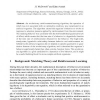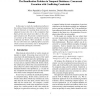562 search results - page 19 / 113 » Distinguishing between cause and effect |
ECAL
2005
Springer
14 years 2 months ago
2005
Springer
An evolutionary reinforcement-learning algorithm, the operation of which was not associated with an optimality condition, was instantiated in an artificial organism. The algorithm ...
CHI
2004
ACM
14 years 8 months ago
2004
ACM
Users of modern GUIs routinely engage in visual searches for various control items, such as buttons and icons. Because this is so ubiquitous, it is important that the visual prope...
RTSS
2006
IEEE
14 years 2 months ago
2006
IEEE
Recent years have seen rapid growth of online services that rely on large-scale server clusters to handle high volume of requests. Such clusters must adaptively control the CPU ut...
IJIS
2010
13 years 5 months ago
2010
In this paper we study the ramification problem in the setting of temporal databases. Standard solutions from the literature on reasoning about action are inadequate because they ...
HPCA
2012
IEEE
12 years 4 months ago
2012
IEEE
Lowering supply voltage is one of the most effective techniques for reducing microprocessor power consumption. Unfortunately, at low voltages, chips are very sensitive to process ...


